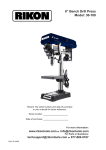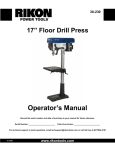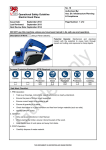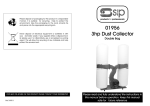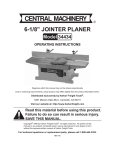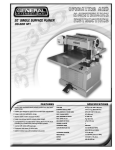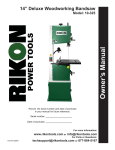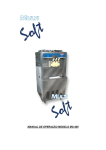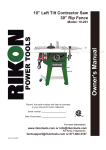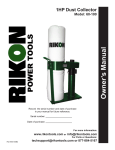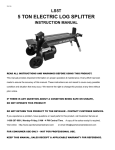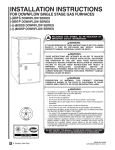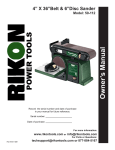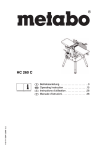Download 25-200 User Manual.indd
Transcript
12" Planer/Jointer Owner’s Manual Model: 25-200 Record the serial number and date of purchase in your manual for future reference. Serial number: Date of purchase: For more information: www.rikontools.com or [email protected] For Parts or Questions: [email protected] or 877-884-5167 Part # 25-200M1 Index 1 GENERAL INFORMATION 1.1 Foreword 2 MACHINE DESCRIPTION 2.1 2.2 2.3 2.4 2.5 2.6 2.7 2.8 Machine identification Getting to know your planer/jointer Technical specification Recommended protective clothing Noise emission Prescribed use of the machine Hazards Safety instructions for the planer/jointer 3 INSTALLATION 3.1 3.2 3.3 3.4 Lifting and unloading Position of the machine Identifying shipping boxes Installation of loose parts 3.4.1 Fence rail installation 3.4.2 Fence installation 3.4.3 Switch installation Electrical connection Dust chute - installation 3.5 3.6 4 ADJUSTMENTS 4.1. Planer table height adjustment 4.2. Infeed table height adjustment 4.3. Jointer fence adjustment 5 OPERATING PROCEDURES 5.1 ON/OFF switch 5.2 Jointer mode 5.3 Planer mode 6 MAINTENANCE 6.1 Replacing cutter knives 6.2 Drive Belt Check 7 DIAGRAMS & COMPONENTS 8 NOTES 2 1. General Information 1.1 FOREWORD This manual must be read and understood before operating the machine. This will provide a better working knowledge of the machine, for increased safety and to obtain the best results. 2. Machine Description 2.1 MACHINE IDENTIFICATION There is a identification plate attached to the rear of the machine, containing machine data and serial number. 2.2 GETTING TO KNOW YOUR PLANER/JOINTER 2 3 5 4 8 7 9 1 6 10 1 Dust chute 6 On/off switch 2 Jointer fence 7 Locking level 3 Infeed table 8 Outfeed table 4 Height setting of infeed table 9 Cutterhead guard 5 Cutterblock 10 Height setting of the planer bed 3 2.3 TECHNICAL SPECIFICATION SPECIFICATION Feed speed sf/min Cutterhead speed rpm Cutterhead diameter Max planer capacity Max planing width Max depth of cut jointer Max depth of cut planer Knives pcs Fence tilting degree Motor power output Net Weight 25-200 23 5300 2.75" 12" x 8" 12.20" 1/8" 1/8" 3 0-45 3HP 386lbs 2.4 RECOMMENDED PROTECTIVE CLOTHING • • • • Non-slip footwear is recommended. Do not wear loose clothing, neckties or jewellery; they can be caught in moving parts. Roll up long sleeves above the elbow. Wear protective hair covering to contain long hair. 2.5 NOISE EMISSION The measurements of noise, in the working position and during operation, were carried out under the standard ISO 7960 Annex B and C: Instantaneous acoustic pressure: Sound power level(no load) <98dB(A) Sound power level(load) <107dB(A) Sound Pressure level(no load) <89dB(A) Sound Pressure level(load) <98dB(A) Constant K=4 dB measured in accordance with EN ISO 3746:1995 The figures quoted are emission levels and are not necessarily safe working levels. Whilst there is a correlation between the emission and exposure levels, this cannot be used reliably to determine whether or not further precautions are required. Factors that influence the actual level of exposure of the workforce include the characteristics of the work room and the other sources of noise etc. i.e. the number of machines and other adjacent processes. Also the permissible exposure level can vary from country to country. This information, however, will enable the user of the machine to make a better evaluation of the hazard and risk. 2.6 PRESCRIBED USE OF THE MACHINE This machine is intended for edge jointimg and thickness planing of solid woods. The permissible workpiece dimensions must be observed (see Technical Specification). Any other use is not as specified. Unspecified use, modification of the machine or use of parts not tested and approved by the equipment manufacturer can cause unforeseen damage. 2.7 HAZARDS ATTENTION Planing and jointing still present risks that cannot be eliminated by the manufacturer. Therefore the user must be aware that wood working machines are dangerous if not used with care and all safety precautions adhered to. 4 2.8 SAFETY INSTRUCTIONS FOR PLANER/JOINTERS A planer/jointer is a tool which can, due to operator carelessness, cause serious personal injury. It is therefore strongly recommended you read and observe: · these instructions, particularly the special safety information in the respective chapters; · the relevant guidelines or regulations for the prevention of accidents pertaining to the use of planer/jointers, where applicable. Keep all documents, supplied with the machine, for future reference. The planer/jointer shall only be started and operated by persons familiar with planer/jointers and who are at any time aware of the dangers associated with the operation of such tool. Persons under 18 years of age shall use this planer/thicknesser only under the supervision of an instructor in the course of their vocational training. The following residual risks do principally exist with planer/jointers and can not, even by employing safety devices, completely eliminated: - Hazard generated by environmental conditions: do not operate the planer/jointer in rain or damp environment. Ensure sufficient lighting. Do not operate the planer/jointer near inflammable liquids or gases. - Hazard to other persons in the work area: Keep bystanders, particularly children, out of the danger zone. - Risk of injury by machine faults: check the planer/jointer for damage before any use. Do not operate the machine with a damaged part. Replace blunt cutter knives at once. Risk of injury by kickback if a blunt knife gets caught in the workpiece's surface. - Risk of injury by an unstable stand of the planer/jointer: when working long stock use suitable supports on both sides of the machine. Avoid adverse body positions. Ensure firm footing, and keep your balance at all times. - Risk of injury by foreign objects in the machine: prior to any starting of the machine ensure that there are no objects (e.g. tools) in the machine. - Risk of injury by workpiece kickback (workpiece is caught by the rotating cutterhead and thrown back against the operator): operate machine only with a fully functional anti-kickback lock. Always use sharp cutter knives. If in doubt check workpiece for inclusion of foreign objects (e.g. nails, screws, lose knots). - Risk of injury by touching the rotating cutterhead: always keep your hands well clear of the cutterhead. Switch machine off and plug out if it is not used. - Danger! Drawing-in/trapping hazard! Take care that no parts of the body or clothing can get caught and drawn in by the rotating cutterblock (do not wear neck ties and garments with wide sleeves; contain long hair with a hairnet). - Risk of injury by cuts with cutterblock at standstill: Wear gloves when changing cutter knives. - Risk of injury by inhaling wood dust: dust of certain timber species (e.g. oak, beech, ash) can cause cancer when inhaled. Use a suitable dust collector: Risk of injury by inadequate personal protection: when planing, wear: - dust respirator; - hearing protection; - safety goggles. California Propsition 65 Warning WARNING: Some dust created by power sanding, sawing, grinding, drilling, and other construction activities contains chemicals known to the State of California to cause cancer and birth defects or other reproductive harm.Your risk from exposure to these chemicals varies, depending on how often you do this type of work. To reduce your exposure, work in a well-ventilated area and with approved safety equipment, such as dust masks that are specially designed to filter out microscopic particles. For more detailed information about California Propostion 65 log onto rikontools.com. 5 3. Installation 3.1. LIFTING AND UNLOADING The machine can be transported by two means: 1. With a forklift truck. To do so, the machine is secured on a pallet with four hex bolts. 2. With help. Here, the machine is carried by means of carrying straps or two battens (A, Fig.1) placed underneath the planer bed. CAUTION Do not move the machine by the infeed and outfeed tables, these are not designed to withstand the tensile load by the A machine weight. FIG. 1 3.2 POSITION OF THE MACHINE CAUTION It is prohibited to install the machine in explosive environments. Ensure that the floor area around the machine is level, well maintained and free from loose material e.g. chips; 1. Remove four mounting bolts from the machine base. 2. Lift machine off the pallet and set down on the floor. 3. Fix the machine to the floor. Fix the machine feet and fix on ground by means of expansion bolts (not supplied). FIG. 2 3.3 IDENTIFYING SHIPPING BOXES BEFORE ASSEMBLY It is advisable that before unpacking to have plenty of paper towels or cloths available to clean off the rust preservative. FIG. 3 6 3.4. INSTALLATIONS OF LOOSE PARTS A 3.4.1 FENCE INSTALLATION - To packaging, the fence seat (A, Fig. 4) is installed incorrectly before shipment. Before installing the fence, taking off both of the hex bolts (B, Fig. 4) and turn the fence seat 180 degrees. B FIG. 4 - Locate the lock level (C. Fig.5) from the loose bag and install it onto the fence seat as Fig.5. C FIG. 5 - Slide the fence guide bar (D, Fig.6) into the fence seat and locking through the level (C, Fig.6) C D FIG. 6 3.4.2 SWITCH - INSTALLATION H - Fit the switch (G, Fig.7) onto the bracket with two hex nuts (H, Fig.7) FIG. 7 7 G 3.4.3 Cutterhead guard - INSTALLATION - Take off both of the hex socket screws (A, Fig.8). Install the B cutterhead guard assembly (B, Fig.8) using two of hex socket screws. Make sure the square washer (C, Fig. 8) stay between the table and cutterhead guard. C A FIG. 8 3.5 ELECTRICAL CONNECTION Electrical installation should be carried out by competent, qualified personnel. The connection should be made using the terminal box. Ensure that the electrical supply corresponds with that of the machine, use cables of a section suitable for the power of the motor. For an electrical supply of 230 V or a power rating greater than 15 A it will be necessary to increase the section of the connecting cables . Connect the phase wires to the terminals R- S - T (L1 - L2 - L3) and the earth wire to the earth terminal. On initial start-up check the direction of rotation, if it is incorrect then invert the two phase wires (for machines with 3 phase supply). Direction of rotation of machines with single-phase supply is pre-determined during production . On completion of the installation check that the terminal box is closed correctly and that the plug points are locked. PT310 Single phase 8 PT310 Three phase 3.6. DUST CHUTE - INSTALLATION A The dust chute complete with suction connector must be installed for planing. CAUTION: The contact pins on the shaft of the dust chute (A, Fig. 9) must engage properly in the limit switch. Incorrectly installed dust chute the machine will not start. Connect a suitable dust collector to the suction connector of the jointer/planer. FIG. 9 4. Adjustment C 4.1. PLANER TABLE HEIGHT ADJUSTMENT Per pass a maximum of 1/8" material can be removed. Workpieces of max. 8" thickness can be planed. D Height adjustment is made with a handwheel (B, Fig.10). One full turn of the crank changes the height of the planer bed (C, Fig.10) by 5/32". B · Clockwise turning = raises the planer bed · Counter-clockwise turning = lowers the planer bed. The planing thickness is indicated on the scale (D, Fig.10). FIG. 10 4.2. INFEED TABLE HEIGHT ADJUSTMENT The infeed table (E, Fig,11) is adjusted by using adjusting lever (G, Fig.11) for edge jointing and surface planing. · The scale (F, Fig.11) next to the adjusting lever (G, Fig.11) E F corresponds to 1/32" material removal. H - After adjustment, tighten ratchet lock lever (H, Fig.11) - Per pass a maximum of 1/8" material can be removed. G FIG. 11 4.3. JOINTER FENCE ADJUSTMENT The jointer fence (I, Fig.12) provides lateral support for the workpiece when surface planing. I · After loosening the ratchet lock lever (J, Fig.12) the jointer L fence can be adapted to the workpiece width. · After loosening the ratchet lock lever (K, Fig.12) & lock pin (L, Fig.12) the jointer fence extrusion can be tilted to the angle between 0°- 45°. K I FIG. 12 9 J 5. Operating Procedures 5.1. ON/OFF SWITCH (Fig.13) · To switch ON = press green switch button. · To switch OFF = close cover or press red switch button. · To unlock the switch cover push the pin on the stop cover. FIG. 13 5.2 SURFACE PLANER MODE: - The workpiece rests on top of the infeed table. - The workpiece is cut on the underside. - The feed direction of the workpiece is exactly opposite than when thickness planing. Workpiece dimensions - Length: use a push stick to feed workpieces shorter than 12" ; for workpieces over 60" use support rollers. - Width: max. 12". - Thickness: min. 1/4". Note: The max. depth of cut for a single pass is 1/8". FIG. 14 1. Assume proper operating position: position yourself to one side of the infeed table. 2. Set jointer fence as required. 3. Set planing thickness. 4. Place workpiece against jointer fence . 5. Adjust cutterhead cover: - when planing narrow edges (jointing) or workpieces more than 3" thick: A Set cutterhead guard from the side against the workpiece (Fig16). FIG. 15 FIG. 16 10 - Planing the face of a plank or workpieces up to 3" thick: lower cutterblock cover from top onto workpiece. Adjust cutterhead guard so that the undermentioned distances are not exceeded in any position: rear edge (A, Fig.17) – workpiece max. 1/64"; front edge (B, Fig.17) – workpiece max. 5/64". 6. Start motor. Caution: The use of push blocks is necessary when face planing thin material. 7. Turn the machine on and place the workpiece on the infeed A table. Feed the workpiece toward the cutterhead exerting B downward pressure until the workpiece clears the cutterhead on the outfeed table side. max. 3 mm max. 2 mm Note: FIG. 17 Before using the jointer fence: 1. Set a try square (C, Fig.18) against the fence extrusion (D, Fig. 18) 2. Loosen both hex bolt (E, Fig.18) and adjust the set screws (F, Fig.18) until fence extrusion is square with the jointer table. D 3. Tighten hex nuts when the fencn extrusion is exactly 90° F 4. Set a mitre square against the fence extrusion. C 5. Hex bolts (G, Fig.19) and adjust hex bolts until fence extrusion is stopped exactly 45°. FIG. 18 FIG. 19 11 E G 5.3. THICKNESS PLANER MODE A Note: Thickness planing is used to reduce a workpiece with one already surface planed surface to a desired thickness. - The workpiece is run through the thicknesser. - The surface already planed flat rests on the thicknesser bed. - The workpiece is cut on the upper side. - The feed direction of the workpiece is exactly opposite than with surface planing. Workpiece dimensions - Length: min. 12"; for workpieces over 60" use roller support. - Width: max. 12". FIG. 20 - Thickness: min 12"; max. 8". Note: The max. depth of cut for a single pass is 1/8". 1. Pull the jointer fence forward fully (Fig.20) and tighten the lock handle (A, Fig.20) 2. Turn clamping lever (B, Fig.21) outward and swing the outfeed table (C, Fig.21) together with the fence to the left. Make sure the outfeed table lock (D, Fig.21) is engaged (When close the outfeed table, please don't forget the release the lock). 3. Turn the dust chute (E, Fig.21) with installed suction connector to the machine and secure with the lock pin (F, Fig.21). 4. Assume proper operating position: - to feed the workpiece into the machine, position yourself offset C E F to one side of the feed opening. D B FIG. 21 - to remove the workpiece from the machine, position yourself offset to one side of the outfeed opening. 5. To thickness plane stock which surfaces are not parallel, use suitable feeding aids (make fitting templates). 6. Set planing thickness. 7. Start motor. 8. Feed workpiece slowly and straight into the planer. It will then be automatically fed through the planer. 9. Guide workpiece straight through the planer. 10. Switch machine off if no further cutting is to be done immediately afterwards. 12 6. Maintenance 6.1 REPLACING CUTTER KNIVES CAUTION! Risk of personal injury by cuts from the cutter knives! Wear gloves when changing cutter knives. To remove the cutter knives: 1. Unplug power cable. 2. Push fence back. 3. Raise cutterhead guard fully and pull extrusion fully outwards. FIG. 22 4. Turn the five hexagon head screws of the cutter knife lockbar fully in wear gloves! (Fig.22). 5. At first remove cutter knife, then cutter knife lockbar from the cutterblock. 6. Clean all surfaces of cutterhead and cutter knife lockbar with a suitable solvent. 4 - 6 mm 7. Place new cutter knife on cutter knife lockbar. 8. Place cutter knife lockbar with the fitted cutter knife into the cutterhead. 9. Check the projection of the knives: - With the provided straight edge gauge . - Place straight edge gauge across outfeed table and cutterhead as shown. - Turn cutterhead by hand one turn against the direction of feed. - The cutter knives are set correctly if the straight edge is moved forward 1/64" to 1/4" by the turning cutterhead. This check must be performed the full length of the cutterhead. (Fig.23) FIG. 23 10. To tighten the cutter knives, turn the five hexagon head screws of the cutter knife lockbar fully out. To prevent distortion of the cutter knife lockbar start with the screws in the centre , then tighten the screws closer to the edges step by step.(Fig.24) Danger! - Do not extend tool when tightening the screws. - Do not tighten bolts by striking the wrench. 11. Return cutterhead guard to its starting position. 12. Pull fence forward. FIG. 24 13 6.2 Drive Belt Check The cutterhead drive belt and the feedgear drive belt need to be checked periodically and retightened if necessary. Both drive A belts are located behind the machine's side panel. B Checking the drive belt: 1. Unplug power cable. 2. Pull the fence (A, Fig.25) forward. 3. Take off the the side panel (B, Fig.25) and belt cover (C, Fig.25). C FIG. 25 4. Check belt tension with thumb pressure. The drive belt should not give more than 3/8" in the center. Tensioning the drive belt: 5. From outside the machine, loosen the four nuts (D, Fig.26) – using board (E, Fig.26) to increase the motor, the cutterhead drive belt will be slackened. CAUTION: When raising the motor with a board, don't damaged the motor wiring box. 6. To tension the cutterhead drive belt, push the motor downward. When belt tension is correct tighten motor mounting nuts (D, Fig.26). E 7. If necessary, remove chips and dust with dust collector or brush. D 8. Replace the side panel and belt cover secure with the screws. FIG. 26 14 7. Diagrams & Components Ref No. Description Ref No. Description 1 2 3 4 5 Screw M6X12 Cover plate Cabinet Rivet nut M6X15 Hex. Nut M4 6 7 8 9 Pan head screw M4X60 Pan head screw M4X8 Plug 15 16 Ref No. Description Ref No. Description 30 31 32 33 34 35 36 37 38 39 40 41 42 43 44 45 46 47 Extended dust port Rivet Bracket Tube Hex. Socket set screw Adjusting washer Anti-kickback finger Shaft Hex. Socket set screw Rubber washer Bearing Cutter block Knife Knife locking bar Special screw for locking bar Spring Mounting tube Tube 48 49 50 51 52 53 54 55 56 57 58 59 60 61 62 63 64 Bearing bracket Hex. Bolt M6X12 Hex. Bolt M8X30 Cutterblock bracket Tighting rod Spring Hex. Nut M6 Flange nut Outfeed roller Infeed roller Hex. Bolt M8X35 Roll pin Spring Cap nut Dust collector Carriage bolt Flat washer 17 Ref No. Description Ref No. Description 90 91 92 93 94 95 96 97 Flat washer Scale plate Infeed table Front shaft Handle shaft Hex. Bolt Lift bracket Spring washer 97 98 99 100 101 102 103 104 105 Spring washer Carriage bolt Lock nut M8 Flat washer Carriage bolt Flat washer Knob Hex. Socket head screw Locking handle 18 Ref No. Description Ref No. Description 130 131 132 133 134 135 136 137 138 139 140 141 142 143 Screw M6X16 Right cover Screw M6x40 Cutterblock guard assembly Cutterblock guard w/cap Infeed table Left cover Screw M6X12 Rotation label Flat washer Left bracket Hex. Nut Special bolt Rear handle 144 145 146 147 148 149 150 151 152 153 154 155 156 Hex. Socket head screw Retaining ring Lock thead bar Bracket Hex. Nut M12 Hex. Nut M8 Hex. Socket head screw Mounting base Hex. Socket set screw Flat washer Hex. Bolt M8X25 Shaft Set screw M6X8 19 Ref No. Description Ref No. Description 170 171 172 173 174 175 176 177 178 179 180 181 182 183 184 185 Hex. Socket head screw Guide shaft Scale Indicator Thickness table Mounting plate Mounting tube Threaded bar Spacer block Shaft tube Hex. Socket set screw Position plate Lift chain wheel Roll pin Threaded bar Screw M8X16 186 187 188 189 190 191 192 193 194 195 196 197 198 199 Bevel gear Retaining ring Shaft tube Roll pin Gear Crank bar Crank bar tube Big handwheel Hex. Nut Handle bolt Crank handle Hex. Socket set screw Drive chain Chain wheel 20 Ref No. Description Ref No. Description 220 221 222 223 224 225 226 227 228 229 230 231 232 233 234 235 236 V belt Motor pulley V belt A1194 Cap nut M8 Lock washer 8 Flat washer 8 Flange bolt M8X25 Motor Chain Lock nut M12 Bearing Flat washer Tube Bolt M12X70 Key 6x16 Spindle pulley Hex. Socket set screw 237 238 239 240 241 242 243 244 245 246 247 248 249 250 251 Lock nut M10 Flat washer Big chain wheel Washer Retaining ring Tube for chain wheel Cam wheel Cam wheel bracket Cam wheel shaft Flat washer Shaft Spring V-blet pulley Bearing Bearing spacer 21 Ref No. Description Ref No. Description 270 271 272 273 274 275 276 277 278 279 280 281 282 283 284 285 286 Cutterhead cover Pan head screw M4x16 Sliding cover Flat washer 4 Sliding cover bracket Nylon nut M4 Jointer fence Pin shaft Pan head screw M4x8 Spring washer 4 Indicator Scale Square nut Jointer fence bracket Slider Pin shaft Spring 287 288 289 290 291 292 293 294 295 296 297 298 299 300 301 302 303 Rotation bracket Pin stop knob Hex bolt M6x30 Special washer Tilt locking handle Sliding locking handle Sliding bracket Hex bolt M8x25 Hex bolt M6x15 Stop bracket Set screw M6x12 Hex bolt M8x12 Washer Guide rail Hex nut Hex bolt M8x16 Warning label 22 Ref No. Description Ref No. Description 330 331 332 333 Safety switch bracket II Screw M4X30 Safety switch Lock nut M5 334 335 336 337 Bracket Small cam wheel Hex. Socket set screw M5X35 Safety switch bracket I 23 8. Notes 24 2-Year Limited Warranty RIKON Power Tools Inc. (“Seller”) warrants to only the original retail consumer/purchaser of our products that each product be free from defects in materials and workmanship for a period of two (2) years from the date the product was purchased at retail. This warranty may not be transferred. This warranty does not apply to defects due directly or indirectly to misuse, abuse, negligence, accidents, repairs, alterations, lack of maintenance or normal wear and tear. Under no circumstances will Seller be liable for incidental or consequential damages resulting from defective products. All other warranties, expressed or implied, whether of merchantability, fitness for purpose, or otherwise are expressly disclaimed by Seller. This warranty does not cover products used for commercial, industrial or educational purposes. This limited warranty does not apply to accessory items such as blades, drill bits, sanding discs or belts and other related items. Seller shall in no event be liable for death, injuries to persons or property, or for incidental, contingent, special, or consequential damages arising from the use of our products. To take advantage of this warranty proof of purchase documentation, which includes date of purchase and an explanation of the complaint, must be provided. To take advantage of this warranty, please fill out the enclosed warranty card and send it to: RIKON Warranty 110 Cummings Park Woburn, MA 01801 The card must be entirely completed in order for it to be valid. If you have any questions please contact us at 877-884-5167 or [email protected]. 25 For more information: 110 Cummings Park Woburn, MA 01801 877-884-5167/781-933-8400 [email protected] www.rikontools.com Copyright Rikon Power Tools, Inc. 2009 Printed in China 3/09


























